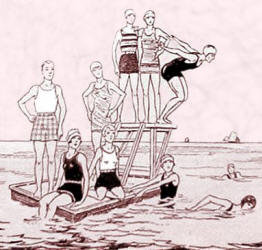

 My father grew up near or on the border of Copiague and Lindenhurst known as American Venice. We have photographs taken at the end of his road looking at the water. Here is a photograph to the right of my father taken near the back of the house. He is dressed in his little sailor outfit. To the left another photograph looking across the street at a neighbor's yard with my father in the foreground. I remember that my father took us to the area where he lived one evening during the summer. He showed us where he lived and told us that the area known as American Venice was originally used for film making before Hollywood became so important to the industry. According to the information that I found on the Internet they do not mention the film making industry but instead it was a real estate venture to bring more people to the suburbs before and after the Great Depression.
My father grew up near or on the border of Copiague and Lindenhurst known as American Venice. We have photographs taken at the end of his road looking at the water. Here is a photograph to the right of my father taken near the back of the house. He is dressed in his little sailor outfit. To the left another photograph looking across the street at a neighbor's yard with my father in the foreground. I remember that my father took us to the area where he lived one evening during the summer. He showed us where he lived and told us that the area known as American Venice was originally used for film making before Hollywood became so important to the industry. According to the information that I found on the Internet they do not mention the film making industry but instead it was a real estate venture to bring more people to the suburbs before and after the Great Depression.Below is a photograph of my Uncle Billy who is standing on the dock near the canals. They lived on 487 John Street in Lindenhurst according to the 1920 Federal Census.The picture taken of my grandmother, Anna Maule probably taken at the end of their block near the canals. It looks like this was taken the same day as the one by the automobile.
 Another photograph of my Uncle with either his brother taken the same day as the previous one on the dock near the canal. This picture was taken of the neighbor's home across the street. They lived in American Venice until 1925 New York Census where we find them living on Wellwood Avenue in Lindenhurst.
Another photograph of my Uncle with either his brother taken the same day as the previous one on the dock near the canal. This picture was taken of the neighbor's home across the street. They lived in American Venice until 1925 New York Census where we find them living on Wellwood Avenue in Lindenhurst.American Venice became a unique place to live through my fathers memories.

"An ornate gazebo sat on an island in the middle of a laguna at the north end of a canal framed by striped mooring poles and gondolas imported from Italy. From their perch of towering columns, statues of winged lions invited passersby to come closer and explore, to saunter over arched Venetian bridges and past Italian-style villas.
This was once the scene not in Venice, Italy, but in American Venice, a unique community created in the 1920s in Copiague, just off the Great South Bay. The Great Depression and a surge of year-round residents eventually transformed American Venice into a conventional suburban neighborhood, and for years the Town of Babylon has been trying to recreate those golden days. But it would require acquisition of a site at the head of the canal, and the town has been unable to persuade the property owner to sell.
American Venice was the brainchild of real estate developers Victor Pisani and Isaac Meister, according to a new book, "Copiague" (Arcadia Publishing), by Babylon town archivist Mary Cascone. At a time when many communities on Long Island were still on the cusp of development, the pair decided to create right in the heart of Copiague an oasis dedicated to a city more than 4,000 miles away."


 Liberated from long skirts, young women of the twenties wore a figure hugging wool jersey sleeveless tank suit.
Liberated from long skirts, young women of the twenties wore a figure hugging wool jersey sleeveless tank suit.






